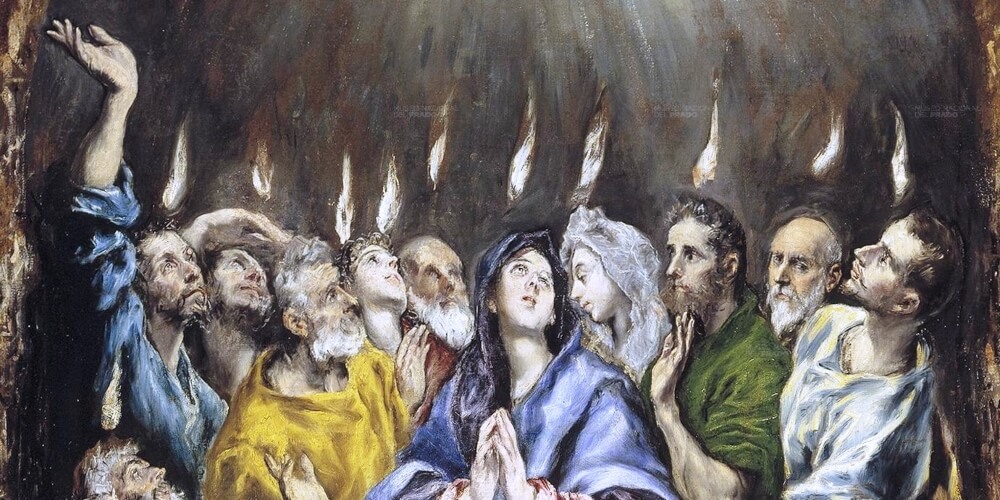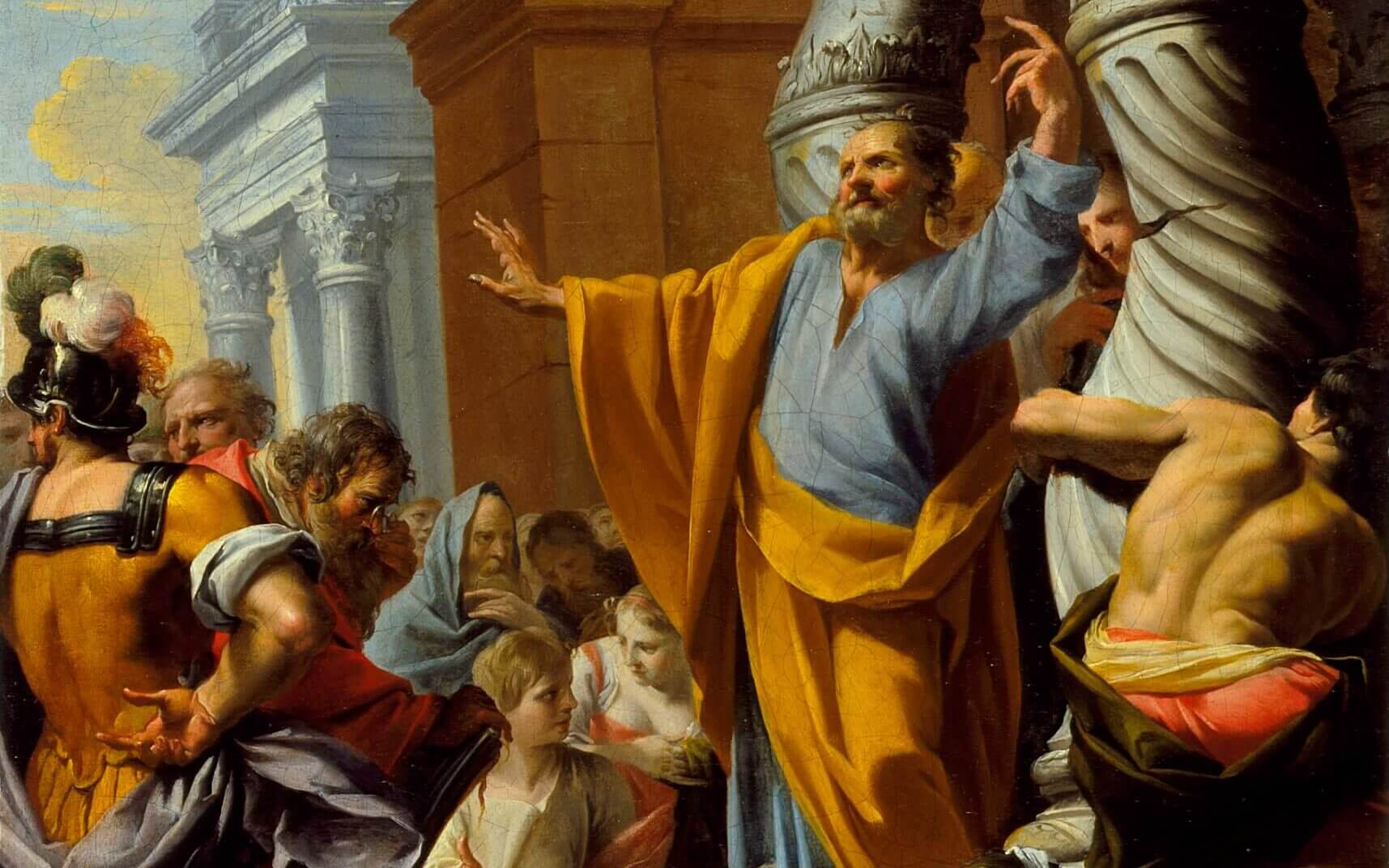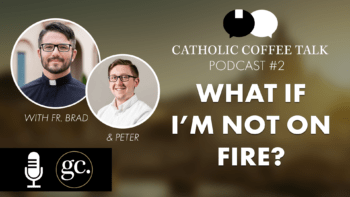
The following article is taken from our series Full of Grace, which explores the power of the Rosary and offers twenty in-depth reflections on the Mysteries of the Rosary.
One of the things we unpack in Full of Grace is the thread of the Old Testament being fulfilled and transformed in the New Testament. This includes the feast of Pentecost.
Most Catholics don’t realize that Pentecost actually has deeply Jewish roots, which are fulfilled through St. Peter and the other Apostles.
The third Glorious Mystery is the Descent of the Holy Spirit. This Mystery’s other common name, “Pentecost,” refers to the Jewish feast during which the Holy Spirit descended upon the Apostles and the Blessed Mother.
By turning our attention to the origins of the Jewish feast of Pentecost, we can uncover the deeper meaning within this Mystery, and see how the Holy Spirit descends upon us today through the ministry and authority of the Catholic Church.
The Feast of Pentecost
Remember that, as part of the Old Covenant, the people of Israel were supposed to travel to Jerusalem for three feasts each year. Pope Benedict writes that by doing this, “Israel remains, as it were, God’s pilgrim people, always journeying toward its God and receiving its identity” from Him.
We have already seen two Mysteries of the Rosary which bring to fulfillment the other two pilgrimage feasts. The Feast of Tabernacles—which celebrated God’s saving presence—is fulfilled in the Transfiguration; the Feast of Passover—the sacrifice that saved Israel from death—is fulfilled in the Eucharist.
Now we see the last of the pilgrimage feasts—Pentecost—brought to glorious fulfillment.
This feast took place every year, about fifty days after Passover, giving the feast its Greek name: pentekoste. This feast commemorated God’s giving of the Law to Moses and, through Moses, to all the people.
The Lord said to Moses, “Come up to me on the mountain [Sinai], and wait there; and I will give you the tables of stone, with the law and the commandment, which I have written for their instruction”…
Then Moses went up on the mountain, and the cloud covered the mountain. The glory of the Lord settled on Mount Sinai, and the cloud covered it six days; and on the seventh day he called to Moses out of the midst of the cloud. Now the appearance of the glory of the Lord was like a devouring fire on the top of the mountain in the sight of the sons of Israel.
Exodus 24:12, 15-17
God spoke to Moses from the cloud of fire, and gave him the Law. The entirety of the next eight chapters of the Book of Exodus explain the laws regarding proper worship of the Lord: how to construct and carry the Ark of the Covenant, how to offer sacrifice, how to ordain priests, how priests are to behave, how to decorate the Lord’s tent…on and on. It was only after Israel received these laws about worship—and after Israel broke these laws by forging the golden calf—that the Lord gave them the Ten Commandments.
Peter Proclaims the New Covenant
The Descent of the Holy Spirit brings the Feast of Pentecost to its glorious fulfillment. God comes down as fire upon His appointed messengers, and sends them to proclaim the New Covenant to His people. St. Peter, the Prince of the Apostles, leads them out into the large crowds—Jews gathered from every nation for this feast—and proclaims the fulfillment of the Old Testament:
“Men of Israel, hear these words: Jesus of Nazareth, a man attested to you by God with mighty works and wonders and signs which God did through him in your midst, as you yourselves know—this Jesus, delivered up according to the definite plan and foreknowledge of God, you crucified and killed by the hands of lawless men. But God raised him up, having loosed the pangs of death, because it was not possible for him to be held by it…
Let all the house of Israel therefore know assuredly that God has made him both Lord and Christ, this Jesus whom you crucified.”
Acts 2:22-24, 36
Here, just as Moses attended to God on Mt. Sinai and received the Law, the Apostles attend to the Holy Spirit and receive the new Law. They do not yet prescribe regulations for worship, but they definitively proclaim the truth around which all worship now orbits: that Jesus of Nazareth, who is Lord and Christ, died and was raised from the dead.

In time, led by the Holy Spirit, they will bring us God’s new law. These men will be the ones to write the Gospels, inspired by the Holy Spirit. They will lead the Church and guide Her, themselves led by the Spirit, in opening up the Church to the whole world.
As priests of the new and universal—that is, “catholic“—covenant, they will lead God’s people in proper worship and sacrifice in the Eucharist, as they were commanded by Jesus. Following His commands, they will bring Baptism and all the sacraments to the ends of the earth.
Mary: Mother of the Church
We should not neglect Mary’s role in this foundation of Christ’s Church. Tradition tells us that, following her Son’s command from the Cross to enter St. John’s household, Mary remained always among the Apostles. She was with them when the Spirit descended, as the Mother of the Church.
In the Annunciation we pass from the holiness of the Old Testament to the holiness of Christ. At Pentecost we pass from the holiness of the Historical Christ to the holiness of the Mystical Christ or His Body, which is the Church. Mary here receives the Spirit for a second time. The first overshadowing was to give birth to the Head of the Church; this second overshadowing is to give birth to His Body as she is in the midst of the Apostles abiding in prayer…
As the Son of God in the Incarnation took upon Himself a human body from the womb of the Blessed Mother overshadowed by the Holy Spirit, so now on Pentecost He takes from the womb of humanity a Mystical Body, as the Holy Spirit overshadowed the twelve Apostles with “Mary in the midst of them abiding in prayer.”
Venerable Fulton Sheen, The World’s First Love
The Blessed Mother knew the Spirit already, for it was the Holy Spirit that overshadowed her at the Annunciation. She is the spouse of the Holy Spirit. At Pentecost and afterwards, she gently guides her children to a deeper understanding of the Holy Trinity.
In this way, Mary goes before her children, leading us and showing us the way to heavenly glory. Gentle and maternal leadership permeated her whole earthly life, and as we will see tomorrow, she even goes before us—body and soul—into the glory of a new life with Christ.
We hope you’ve enjoyed this excerpt of Full of Grace. You can enroll in this series, here. Join us, and explore the other Mysteries of the Rosary, as well as the power of Marian devotion in your life.
If you enjoyed this excerpt, you might also be interested in The Life of Christ, where we move through the Gospels, placing the events of Jesus’ life in their historical and Biblical contexts, and illuminate them through the eyes of faith.


